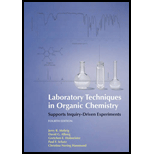
Interpretation:
The reason to connect water to a condenser so it flows in at bottom and out at top should be determined.
Concept introduction:
Many organic reactions are non-spontaneous and to proceed they require heat. The heating of reagents mixture in open containers causes evaporation of the compounds while heating in the close container can cause an explosion.
Explanation of Solution
The condenser is an apparatus that is used in the laboratory to cool the heated liquid. It is vertically mounted above reaction flask and provides a method to cool vapor so that it condenses and flows back in reaction flask.
The condenser is cooled by water or air. Therefore, water is connected to condenser so it can be ensured that there are no air bubbles and can efficiently cool the glass wall of the condenser.
Want to see more full solutions like this?
Chapter 7 Solutions
Laboratory Techniques in Organic Chemistry
- Define Solid aerosol, solid foam and solid solarrow_forwardSatellites in space often suffer from vacuum welding, in which two metal parts in contact tend to stick together more than expected over a period of time. Why does this phenomenon occur in space and not on Earth?arrow_forwardWhat should be the surface tension of a liquid if its density, which is 1.44 g/cc, is the same as that of the calibrating liquid? The displacements of the liquid and the calibrating liquid inside the capillary tube are both 0.5 cm. The surface tension of the calibrating liquid is 29.4509 dynes/cm. * O 29.5409 dynes/cm 35.9587 dynes/cm O 14.7255 dynes/cm O No answer from the choicesarrow_forward
- Imagine you have 3 beakers of water. The water temperature in beaker 1 is 0°C, in beaker 2 is 24°C and in beaker 3 is 45°C. If you place same amount of potassium permanganate crystals into these 3 beakers, predict what would happen to the crystals in these three beakers. Compare the predicted relative diffusion rate in these beakers, explain why.arrow_forward1 Why do you need to lower the heat of your stove when the meat you are cooking is not yet tender and the water has reached its boiling point? 2 Which is better, wear two layers of jacket or a single jacket of the same mass in a very cold weather? 3 How does a pressure cooker works?arrow_forwardEvaporative cooling is most efficient in dry weather. Is true or Falsearrow_forward
- The vapor pressure of pure H20 depends on what?arrow_forwardExplain why, if you pour very carefully, you can actually “stack” water slightly above the rim of a cup.arrow_forwardStep 1. A phase diagram has three areas marked solid, liquid and vapour. A substance would be a solid if it falls into the area of the solid in the phase diagram. To make this point even clearer, color the three areas with three different-colored crayons. anssad Make sure to make each area as distinct as possible to the other areas. sold iquid vapour temperatrearrow_forward
- Part A. Use these facts on the heating and cooling curve of water in answering the following activities. Direction: Analyze each of the following statements whether it describes the heating and cooling curve of water. Write TRUE if the statement is correct but if it’s false, change the underlined word or group of words to make the whole statement true. Write your answer on a separate sheet of paper. 2. At point B of the cooling curve, all the vapor is now condensed into water.arrow_forwardIt is already known the specific heat of water is 4200 J/kg/°C. The vaporization energy of water is 2.3 x 103 kJ.kg'. One single heliostat (1 m² area) in a CSP station collects 104 W/m² solar energy. Assume all the heat could be used; to generate 2 Kg water (20 °C, 1 atmosphere) into steam completely by two heliostats, at least how many seconds will be needed? 527.2 s 131.8 s O 263.6 s O Neverarrow_forwardWhy does surface tension allow the fly fisherman’s hook to float on water?arrow_forward
 Physical ChemistryChemistryISBN:9781133958437Author:Ball, David W. (david Warren), BAER, TomasPublisher:Wadsworth Cengage Learning,
Physical ChemistryChemistryISBN:9781133958437Author:Ball, David W. (david Warren), BAER, TomasPublisher:Wadsworth Cengage Learning, Introductory Chemistry: An Active Learning Approa...ChemistryISBN:9781305079250Author:Mark S. Cracolice, Ed PetersPublisher:Cengage LearningChemistry: Matter and ChangeChemistryISBN:9780078746376Author:Dinah Zike, Laurel Dingrando, Nicholas Hainen, Cheryl WistromPublisher:Glencoe/McGraw-Hill School Pub Co
Introductory Chemistry: An Active Learning Approa...ChemistryISBN:9781305079250Author:Mark S. Cracolice, Ed PetersPublisher:Cengage LearningChemistry: Matter and ChangeChemistryISBN:9780078746376Author:Dinah Zike, Laurel Dingrando, Nicholas Hainen, Cheryl WistromPublisher:Glencoe/McGraw-Hill School Pub Co General Chemistry - Standalone book (MindTap Cour...ChemistryISBN:9781305580343Author:Steven D. Gammon, Ebbing, Darrell Ebbing, Steven D., Darrell; Gammon, Darrell Ebbing; Steven D. Gammon, Darrell D.; Gammon, Ebbing; Steven D. Gammon; DarrellPublisher:Cengage Learning
General Chemistry - Standalone book (MindTap Cour...ChemistryISBN:9781305580343Author:Steven D. Gammon, Ebbing, Darrell Ebbing, Steven D., Darrell; Gammon, Darrell Ebbing; Steven D. Gammon, Darrell D.; Gammon, Ebbing; Steven D. Gammon; DarrellPublisher:Cengage Learning




